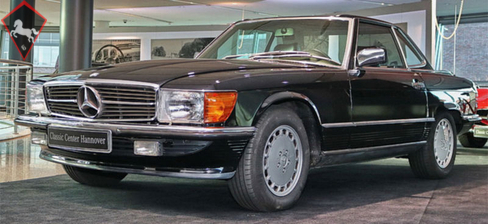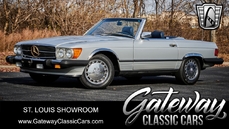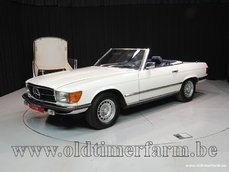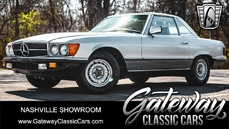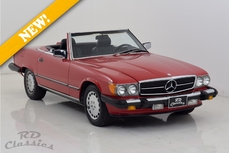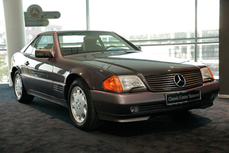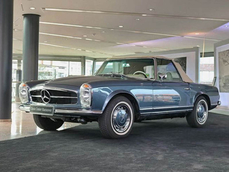Mercedes-Benz 500SL w107 SL (1988) in 040 " Glanzschwarz" 1988
General description :
Preis:
EUR 77.850,– (Differenzbesteuert nach § 25 A)
Fahrzeughistorie:
1971 feierte eine neue SL-Baureihe (R107) Premiere. Der "Pagoden-SL" hatte einen Nachfolger bekommen. Und wieder war ein großer Wurf gelungen. Für die moderne Karosserie des Roadster zeichnete der damalige Mercedes-Chefdesigner Friedrich Geiger verantwortlich, aus dessen Feder auch der legendäre 300SL Flügeltürer und das fulminante 111er Cabrio stammte. Erstmals waren Stilelemente wie z. B. die Breitbandscheinwerfer und die geriffelten Rückleuchten zu finden, die für alle Mercedes-Modelle dieser Epoche prägend werden sollten. Ein wichtiges Thema bei Mercedes war damals schon die Sicherheit. Mit seiner stabilen Bodengruppe, Knautschzonen vorn und hinten, einer gestaltfesten Fahrgastzelle sowie einer hochstabilen A-Säule erfüllte der SL alle bekannten Sicherheitsaspekte, und er konnte sogar auf einen Überrollbügel verzichten, was sehr zum offenen Fahrspass beitrug. Obwohl der Wagen durchaus sportlich ausgelegt war, wurde auch auf Komfort größter Wert gelegt. Für damalige Roadster war das nicht so selbstverständlich wie heute. Sportlich, komfortabel, elegant zugleich und absolut alltagstauglich. Vielleicht ist es gerade diese Kombination, die dieses Modell langfristig so beliebt gemacht hat. Für den Antrieb sorgten ausschließlich 6 und 8-Zylinder Motoren, mit 185 bis 240 PS, die der neue Alu-Motor im 500 SL - erkennbar an der dezenten Gummi-Lippe auf dem Heckdeckel - am Ende leistete.
Bemerkenswert ist die Bauzeit des SL 107: Mitte 1989 lief nach 18-jähriger Produktion der letzte von sage und schreibe 237.287 Exemplaren vom Band - und fuhr direkt ins Mercedes-Museum.
Dieses Fahrzeug:
Dieser 500SL war für den Inlandsmarkt vorgesehen und entspricht somit der deutschen Spezifikation. Er wurde von seinem Käufer kurz nach Auslieferung auf dem "Grauen Markt" nach Japan exportiert. Zweifelsfrei gehörte er zu den Exemplaren, die dort von ihren Besitzern als Statussymbol angesehen und bestens gepflegt wurden. Eine regelmäßige Wartung, nur wenige Kilometer und ein sehr guter allgemeiner Zustand (eine komplette neue Lackierung ist durchgeführt worden) lassen darauf schließen. Vor zwei Jahren kam der Wagen zurück nach Deutschland. Nach einer gründlichen Durchsicht, mit neuem TÜV und einer Gebrauchtwagen-Garantie steht er für einen neuen Besitzer bereit...
Übrigens: Einer der sehr seltenen 500SL in 040 " Glanzschwarz". Selten deshalb, weil eine Metallic-Lackierung (allgemein gegen Aufpreis) bei diesem Modell zum Serienumfang gehörte. Damals erhielt der Käufer bei Wahl einer Serienlackierung keine Gutschrift, und viele Kunden wählten daher 199 "Blauschwarz-Metallic".
Sonderausstattung & Zubehör:
Klimatisierungsautomatik
Sitzheizung Vordersitze
Armlehne klappbar vorne
Fondsitzbank
Tempomat
Wärmedämmendes Glas
Außentemperaturanzeige
Außenspiegel rechts
Radio Becker Traffic Pro
Autom. Antenne
Änderungen, Irrtümer und Zwischenverkauf vorbehalten.
1988 Mercedes-Benz 500SL w107 SL (1988) in 040 " Glanzschwarz" is listed for sale on ClassicDigest in Podbielskistraße 293DE-30655 Hannover by Daimler AG, vertreten durch die Mercedes-Benz PKW GmbH, Ndl. Hannover | Classic Center Hannover for €77850.
Car Facts
Car type : Car Make : Mercedes-Benz Model : 500SL w107 Model Version : SL (1988) in 040 " Glanzschwarz" Engine size : 4.9 Model Year : 1988 Sub type : Convertible Location : Podbielskistraße 293DE-30655 Hannover Vehicle Registration : Undefined
77850 €
Seller Information
Daimler AG, Mercedes-Benz Classic Center Hannover
Daimler AG, vertreten durch die Mercedes-Benz PKW GmbH, Ndl. Hannover | Classic Center Hannover
+49 (0)511 5154451599
Daimler AG, vertreten durch die Mercedes-Benz PKW GmbH, Ndl. Hannover | Classic Center Hannover
+49 (0)511 5154451599
People who viewed this Mercedes-Benz 500SL w107 also viewed similar Mercedes-Benz listed at ClassicDigest
Other cars listed for sale by this dealer
About Mercedes-Benz
In the annals of automotive history, the journey of Mercedes-Benz is a tale that unfolds with the ingenuity of its founding pioneers. In the year 1886, Karl Benz crafted the Benz Patent Motorwagen, a creation that would go down in history as the world's inaugural automobile. Unbeknownst to him, this moment marked the genesis of what would evolve into the most illustrious premium car manufacturer globally. The financial underpinning of this pioneering venture, interestingly, was provided by Karl Benz's wife, Bertha Benz, demonstrating a remarkable partnership that would set the tone for Mercedes-Benz's legacy.A parallel narrative emerged not far away, as Daimler-Motoren-Gesellschaft, founded by Gottlieb Daimler and Wilhelm Maybach, entered the scene. In 1901, they unveiled their automobile under the now-famous moniker "Mercedes," meaning "godsend" in Spanish. This name was bestowed upon the car at the behest of Emil Jellinek's daughter, the distributor for Daimler-Motoren-Gesellschaft. The wheels of innovation were set in motion.
Fast forward to 1926, a pivotal year that witnessed the merger of Daimler with Benz & Cie., culminating in the birth of Daimler-Benz. The amalgamation saw the adoption of "Mercedes-Benz" as the distinguished trademark for their automobiles, fusing the legacies of two visionary entities into one.
Contrary to perceptions of conservatism, the trajectory of Daimler-Benz unfolds as a chronicle of industry firsts. From the introduction of the honeycomb radiator to the float carburetor, and the pioneering implementation of four-wheel brakes in 1924, Daimler-Benz consistently pushed the boundaries of automotive innovation. The diesel-powered Mercedes-Benz 260 D in 1936 marked the inception of diesel engines in passenger cars. The iconic Mercedes-Benz 300SL Gullwing made history as the first car with direct fuel injection, albeit the Gutbrod's tiny 2-stroke engine can claim precedence.
Safety innovations became a hallmark, with Béla Barényi's patented safety cell design in the "Ponton"-models in 1951, featuring front and rear crumple zones. The W116 450SEL 6.9 saw the introduction of the Anti-Lock Brake system (ABS), another pioneering safety feature. From the first production airbags and beyond, the legacy of "firsts" continued to be etched into the fabric of Daimler-Benz.
Over its centennial journey, Mercedes-Benz has not merely produced cars but has sculpted automotive icons. The SSKL, 710 SSK Trossi Roadster, 770K Grosser, 540K Spezial Roadster, 300SL Gullwing, w100 600 Pullman, w111 280SE 3.5 Flachkühler, w113 230SL Pagoda, w109 300 SEL 6.3, and w201 2.3-16 Cosworth stand testament to the brand's commitment to engineering excellence.
The roaring Silver Arrows, or "Silberpfeile," including the W 25, W 125, W154, W165, and W196, created a legacy of dominance on the racetrack. These machines were not merely cars; they were expressions of precision, speed, and an indomitable spirit that left their competitors in the dust.
As Mercedes-Benz marches into the future, it does so not just as an automaker but as a custodian of a legacy, a torchbearer of innovation, and a beacon of automotive excellence. The road ahead is sure to witness the continued fusion of cutting-edge technology, timeless design, and an unwavering commitment to setting new standards in the world of automobiles.
One luminary figure who left an indelible mark was Béla Barényi, often heralded as the "father of passive safety" for his pioneering work in safety engineering. His patented safety cell design, featuring front and rear crumple zones, became a hallmark of Mercedes-Benz's commitment to occupant safety, setting new standards that reverberated throughout the automotive world.
Moving through the chronicles, the collaborative genius of Wilhelm Maybach, alongside Gottlieb Daimler, laid the foundation for Daimler-Motoren-Gesellschaft. Their innovations not only birthed the first Mercedes but established a culture of relentless pursuit of technological excellence that remains integral to Mercedes-Benz's DNA.
In the post-merger era of 1926, Ferdinand Porsche emerged as a prominent figure within Mercedes-Benz. His work on the Mercedes-Benz S-Type, a supercharged race car, garnered acclaim and set the stage for a legacy that extended far beyond the marque. Porsche's impact would later extend to his eponymous company, but his influence at Mercedes-Benz during those formative years was pivotal.
As the 20th century progressed, the legendary Rudolf Uhlenhaut emerged as a key figure. Uhlenhaut, an accomplished engineer and the driving force behind the iconic Silver Arrows, played a crucial role in Mercedes-Benz's dominance in motorsports. His engineering prowess and attention to detail were instrumental in creating some of the most formidable racing cars of the era.
In the latter half of the century, figures like Bruno Sacco, the head of design at Mercedes-Benz from 1975 to 1999, left an indelible imprint on the brand's aesthetic identity. Sacco's design philosophy, characterized by clean lines and timeless elegance, shaped iconic models like the W126 S-Class and the W201 190E, solidifying Mercedes-Benz's reputation for luxury and sophistication.
The narrative would be incomplete without acknowledging the contributions of engineers like Hans Scherenberg, whose leadership in the 1970s ushered in a new era of technological innovation at Mercedes-Benz. Scherenberg's tenure saw the development of groundbreaking technologies, including the Anti-Lock Brake system (ABS) and the introduction of airbags in production cars.
